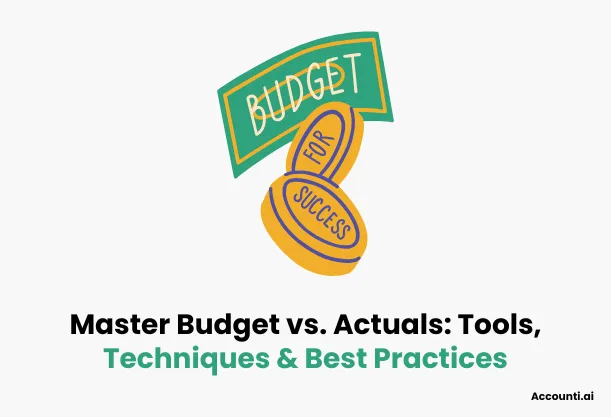
Master Budget vs Actuals: Tools, Techniques, and Best Practices
Budget vs actuals is a fundamental concept in financial management that compares projected financial outcomes (the budget) with the real-world results (the actuals). This comparison is crucial for both individuals and businesses seeking to maintain financial discipline, assess performance, and make informed decisions. In this article, we will dive deep into what budget vs actuals means, why it’s important, and how to effectively use it as a tool for financial success.
What is Budget vs Actuals?
A budget is a financial plan that outlines expected income and expenses over a specific period. Whether it’s a monthly household budget or an annual business forecast, a budget serves as a guide for allocating resources, controlling costs, and achieving financial goals.
- Purpose of Budgeting:
- To forecast revenues and expenses.
- To identify financial priorities.
- To ensure there’s a plan to meet financial obligations and goals.
Actuals refer to the real financial outcomes recorded over the same period. This includes actual income, expenditures, and other financial transactions. Unlike budgets, which are hypothetical projections, actuals represent factual data derived from day-to-day operations.
- Examples of Actuals:
- Salaries paid.
- Revenue earned from sales.
- Utility bills and other recurring expenses.
By comparing the two, organizations and individuals can measure performance, identify discrepancies, and make adjustments as needed.
Why is Budget vs Actuals Important?
Financial Clarity
When you compare your budgeted figures to actual results, you gain a clear understanding of where your money is going. This insight helps in:
- Tracking financial performance.
- Determining whether you’re staying within your financial limits.
- Spotting inefficiencies or overspending areas.
Identifying Variances
A variance is the difference between budgeted and actual figures. Analyzing variances is key to understanding financial performance.
- Types of Variances:
- Positive Variance: When actual income exceeds budgeted income or when actual expenses are lower than budgeted expenses.
- Negative Variance: When actual income falls short of budgeted income or actual expenses exceed budgeted expenses.
- Causes of Variances:
- Unexpected expenses (e.g., equipment failure).
- Over- or underestimation in the budgeting phase.
- Changes in market conditions.
Improving Decision-Making
The insights gained from budget vs actuals analysis empower better decision-making. For instance:
- Adjusting spending habits to stay on track.
- Redirecting funds toward high-performing areas.
- Reassessing financial goals based on real-time performance.
Key Steps to Perform Budget vs Actuals Analysis
Step 1: Set Clear Goals
Before creating a budget, it’s essential to set specific and realistic financial goals. These goals should align with your overall objectives, whether they’re personal savings targets or business profitability benchmarks.
- Tips for Effective Budgeting:
- Break down goals into short-term and long-term categories.
- Use historical data to create realistic projections.
Step 2: Track Your Actuals
Accurate tracking of actual financial data is crucial. Without reliable records, the comparison becomes meaningless.
- Methods for Tracking Actuals:
- Use accounting software like QuickBooks or Wave.
- Maintain detailed spreadsheets.
- Regularly reconcile accounts to ensure accuracy.
Step 3: Compare and Analyze
Once you have both budgeted and actual figures, compare them side by side.
- Steps to Analyze Variances:
- Identify areas where variances occur.
- Determine whether the variances are positive or negative.
- Investigate the reasons behind significant discrepancies.
Step 4: Take Corrective Actions
After identifying variances, implement corrective measures to stay on track.
- Examples of Corrective Actions:
- Cutting discretionary spending if expenses exceed budget.
- Adjusting future budgets to reflect more realistic projections.
- Reallocating resources to underperforming areas.
Tools and Techniques for Budget vs Actuals
Popular Software and Tools
Technology makes it easier than ever to track and analyze budget vs actuals. Here are some popular tools:
|
Tool |
Features |
Best For |
|
QuickBooks |
Automated tracking, reports, and analysis |
Small and medium businesses |
|
Excel |
Customizable spreadsheets for detailed tracking |
Individuals and businesses |
|
Mint |
Expense tracking and budgeting for individuals |
Personal finance |
|
Wave |
Free accounting software for small businesses |
Entrepreneurs |
Methods for Analysis
- Variance Analysis: Focus on areas with the largest variances to understand the root causes.
- Trend Identification: Analyze patterns over time to predict future financial behavior.
Visualization Techniques
Visualization helps make sense of complex data. Charts and graphs are particularly effective for presenting budget vs actuals comparisons.
- Common Charts Used:
- Bar Charts: For comparing income and expenses.
- Line Charts: To track trends over time.
- Pie Charts: To show proportions of budgeted vs actual spending.
Challenges in Budget vs Actuals Analysis
Data Accuracy Issues
Errors in recording actuals or preparing the budget can lead to misleading results. To avoid this:
- Double-check all entries.
- Use reliable software to minimize human error.
Resistance to Change
In organizations, employees or management may resist changes based on budget vs actuals analysis.
- How to Overcome Resistance:
- Communicate the benefits of the analysis.
- Involve stakeholders in the budgeting process.
Time and Resource Constraints
Performing regular budget vs actuals reviews can be time-consuming, especially for small businesses or individuals with limited resources.
- Solutions:
- Automate tracking with software.
- Set up periodic reviews rather than daily comparisons.
Benefits of Regular Budget vs Actuals Review
Improved Financial Health
Regular reviews ensure you’re on track to meet financial goals and reduce the risk of overspending.
Enhanced Accountability
Comparing budgeted and actual figures holds individuals and teams accountable for their financial decisions.
Better Forecasting and Planning
By learning from past variances, you can create more accurate budgets in the future.
Conclusion
Budget vs actuals analysis is a vital tool for anyone aiming to achieve financial success. By setting realistic budgets, tracking actuals, and analyzing variances, you can gain deeper financial insights, make informed decisions, and adjust strategies to stay on track. Whether you’re managing personal finances or running a business, regular budget vs actuals reviews can lead to better outcomes, improved accountability, and long-term financial stability.
FAQs
What does actuals mean in budgeting?
In budgeting, "actuals" refer to the real financial outcomes that have occurred over a specific period. These figures represent the actual income earned and expenses incurred, as opposed to the projected numbers outlined in the budget. Comparing actuals to budgeted figures helps organizations assess financial performance and identify variances.
How to show actuals vs budget?
Presenting actuals versus budget can be effectively achieved through various visualization methods:
- Tables: Provide a clear, side-by-side comparison of budgeted and actual figures.
- Bar Charts: Illustrate differences between budgeted and actual amounts for multiple categories.
- Line Charts: Depict trends over time, showing how actual performance aligns with budgeted expectations.
Selecting the appropriate visualization depends on the data and the insights you wish to convey.
How do you calculate the difference between budget and actual?
The difference between budgeted and actual figures, known as variance, can be calculated using two methods:
- Dollar Variance: Subtract the budgeted amount from the actual
amount:
Dollar Variance = Actual Amount - Budgeted Amount - Percentage Variance: Divide the dollar variance by the budgeted
amount and multiply by 100 to get a percentage:
Percentage Variance = ((Actual Amount - Budgeted Amount) / Budgeted Amount) × 100
These calculations help in understanding the extent of deviation from the budget.
How do you report budget vs actual?
Reporting budget versus actual involves several key steps:
- Data Collection: Gather both budgeted figures and actual financial data for the reporting period.
- Variance Analysis: Calculate variances to identify differences between budgeted and actual figures.
- Visualization: Use tables, charts, or graphs to present the data clearly.
- Interpretation: Analyze the variances to understand the reasons behind them and assess their impact.
- Reporting: Compile the findings into a report, highlighting significant variances and providing explanations or action plans as needed.
This structured approach facilitates effective communication of financial performance.
What is the difference between budget and actual KPI?
Key Performance Indicators (KPIs) are metrics used to evaluate success in specific areas. The difference between budgeted and actual KPIs lies in their projected versus realized values:
- Budgeted KPIs: These are target values set during the planning phase, representing desired performance levels.
- Actual KPIs: These reflect the real performance achieved during the period.
Comparing budgeted to actual KPIs helps organizations assess whether they are meeting their performance objectives and identify areas needing improvement.

 Rohit Kapoor
Rohit Kapoor

